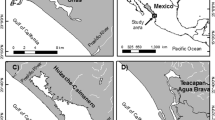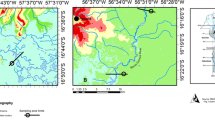Abstract
The knowledge of Hg concentrations in fish is of considerable interest since these organisms are a major source of protein to coastal human populations and fishing communities. The main source of human exposure to Hg contamination occurs through the consumption of fish. In this paper, we compare Hg concentration in 13 fish species from Jaguaribe River lower basin and an adjacent coastal region in the northeastern coast of Brazil. We sampled fish from three stretches of the river: fluvial, estuarine, and marine regions. We tested the hypothesis that Hg concentration in muscle tissue vary according to species, location, and trophic level. Significant differences were observed among species and trophic level, but these could not be observed among the regions studied. As expected, the highest concentrations were observed in carnivorous fish (5.6–107.5; 26.9 ± 18.8 ng g−1). Hg concentrations observed in this study are similar to those observed in regions of low environmental contamination. We estimated Hg intake to vary between 0.02 and 0.22 ng Hg kg body weight−1 week−1, for the average body weight of 56.7 kg, which was considered as low exposure and therefore, a low risk to consumers of fish from the regions studied.




Similar content being viewed by others
References
Adair MB, Cobb GP (1999) Improved preparation of small biological samples for mercury analysis using cold vapor atomic absorption spectroscopy. Chemosphere 38:2951–2958
ANVISA, Agência Nacional de Vigilância Sanitária. Portaria no. 685, de 27 de agosto de 1998 (1998) http://e-legis.anvisa.gov.br/leisref/public/showAct.php?mode=PRINT_Version&id=90. Accessed 15 March, 2013
Azevedo JS, Sarkis JES, Oliveira TA, Ulrich JC (2012) Tissue-specific mercury concentrations in two catfish species from the Brazilian coast. Braz J Oceanogr 60:211–219
Barletta M, Lucena LRR, Costa MF, Barbosa-Cintra SCT, Cysneros FJA (2012) The interaction rainfall vs. Weight as determinant of total mercury concentration in fish from a tropical estuary. Environ Poll 167:1–6
Bastos WR, Gomes JPO, Oliveira RC, Almeida R, Nascimento EL, Bernardi JVE, Lacerda LD, Silveira EG, Pfeiffer WC (2006) Mercury in the environment and riverside population in the Madeira River basin, Amazon, Brazil. Sci Total Environ 368:344–351
Bezerra MF, Lacerta LD, Lima EHSM, Melo MTD (2013) Monitoring mercury in green sea turtles using keratinized carapace fragments (scutes). Mar Pollut Bull 77:424–427
Burguer J (2008) Fishing, fish consumption, and awareness about warnings in a university community in central New Jersey in 2007, and comparisons with 2004. Environ Res 108:107–116
Burguer J, Gochfeld M (2007) Risk to consumers from mercury in pacific cod (Gadus macrocephalus) from the Aleutians: fish age size effects. Environ Res 105:276–284
Canada H (2007) Human health risk assessment of mercury in fish and health benefits of fish consumption. The Minister of Health, Ottawa, 76 p
Costa MF, Barbosa SCT, Barletta M, Dantas DV, Kehrig HA, Seixas TG, Malm O (2009) Seasonal differences in mercury accumulation in Trichiurus lepturus (cutlassfish) in relation to length and weight in a northeast Brazilian estuary. Environ Sci Pollut Res 16:423–430
Costa MF, Landing WM, Kehring HA, Barletta M, Holmes CD, Barrocas PRG, Erves DC, Buck DG, Vasconcelos AC, Hacon SS, Moreira JC, Malm O (2012) Mercury in tropical and subtropical coastal environments. Environ Res 119:88–100
Costa BGB, Soares TM, Torres RF, Lacerda LD (2013) Mercury distribution in a mangrove tidal creek affected by intensive shrimp farming. B Environ Contam Toxicol 90:537–541
Dias FJS, Marins RV, Maia LP (2009) Hydrology of a well-mixed estuary at the semi-arid northeastern Brazilian coast. Acta Limnol Bras 21:377–385
Domingo JL, Bocio A, Falcó G, Llobet JM (2007) Benefits and risk of fish consumption. Part I. A quantitative analysis of the intake of omega-3 fatty acid and chemical contaminants. Toxicol 230:219–226
FAO, Food and Agriculture Organization of the United Nations (2010) The state of world fisheries and aquaculture, Rome, 218 p
Gentès S, Maury-Brachet R, Guyoneaud R, Monperus M, André JM, Davail S, Legeay A (2013) Mercury bioaccumulation along food webs in temperate aquatic ecosystems colonized by aquatic macrophytes in south western France. Ecotoxicol Environ Saf 91:180–187
Harris HH, Pickering IJ, George GN (2003) The chemical form of mercury in fish. Science 301:1203
Küttner VT, Mirlean N, Baisch PRM, Kütter MT, Silva-Filho EV (2009) Mercury in freshwater, estuarine, and marine fishes from southern Brazil and its ecological implication. Environ Monit Assess 159:35–42
Lacerda LD, Soares TM, Costa BGB, Godoy MDP (2011) Mercury emission factors from intensive shrimp aquaculture and their relative importance to the Jaguaribe River estuary, NE Brazil. B Environ Contam Toxicol 87:657–661
Lacerda LD, Dias FJS, Marins RV, Soares TM, Godoy JM, Godoy MLDP (2013) Pluriannual watershed discharges of Hg into a tropical semi-arid estuary of the jaguaribe river, NE brazil. J Braz Chem Soc 24:1719–1731
Passos CJS, da Silva DS, Lemire M, Fillion M, Guimarães JRD, Lucotte M, Mergler D (2008) Daily mercury intake in fish-eating populations in the Brazilian Amazon. J Expo Sci Environ Epidemiol 18:76–87
Soares TM, Coutinho DA, Lacerda LD, Moraes MO, Rabelo MF (2011) Mercury accumulation and metallothionein expression from aquafeeds by Litopenaeus vannamei Boone, 1931 under intensive aquaculture conditions. Braz J Biol 71:131–137
UNEP (2013) Global mercury assessment 2013: sources, emissions, releases and environmental transport. UNEP Chemicals Branch, Geneva, Switzerland
USEPA, Guidance for Assessing Chemical Contaminants data for use in fish Advisories (2013) http://www.epa.gov/ost/fishadvice/volume2. Accessed 15 March, 2013
Vaisman AG, Marins RV, Lacerda LD (2005) Characterization of the mangrove oyster, Crassostrea rhizophorae, as a biomonitor for mercury in tropical estuarine system, northeast brazil. Bull Environ Contam Toxicol 74:582–588
WHO – World Health Organization (1989) Mercury – environmental aspects. Geneva, 1989. Environmental Health Criteria 85: 115p. http://www.inchem.org/documents/ehc/ehc/ehc086.html. Assessed 15 March, 2013
WHO – World Health Organization (2007) Exposure to mercury: a major pubic health concern. Public Health and Environment, 20. Geneva
Author information
Authors and Affiliations
Corresponding author
Additional information
Responsible editor: Philippe Garrigues
Rights and permissions
About this article
Cite this article
Costa, B.G.B., Lacerda, L.D. Mercury (Hg) in fish consumed by the local population of the Jaguaribe River lower basin, Northeast Brazil. Environ Sci Pollut Res 21, 13335–13341 (2014). https://doi.org/10.1007/s11356-014-3297-6
Received:
Accepted:
Published:
Issue Date:
DOI: https://doi.org/10.1007/s11356-014-3297-6




